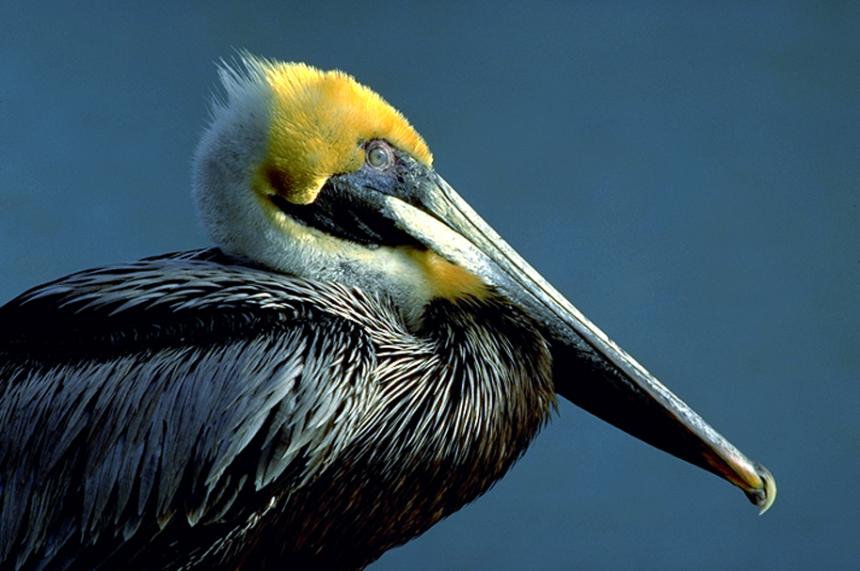Moderate
The brown pelican has recovered from its previous population decline. U.S. Fish and Wildlife Service removed it from the federally endangered species list in 2009; in Washington, the species was removed from the state endangered list in 2016.
Description and Range
Physical description
The brown pelican is 4 feet in length and has a 8 foot wingspan.
Ecology and life history
Brown pelicans inhabit mainly coastal waters and are rarely seen inland or far out at sea. They feed mostly in shallow estuarine waters and occasionally up to 40 miles from shore. They use sand spits, offshore sand bars, and islets for nocturnal roosting and daily loafing, especially non-breeders and during the non-nesting season.
Dry roosting sites are essential. Brown pelicans that roost on beaches can be disturbed by humans, including pedestrians and motorists.
The brown pelicans present seasonally in Washington belong to the California subspecies (P. o. californicus). These pelicans do not breed in Washington, although a few nests have recently been found along the lower Columbia River. They breed in colonies on small offshore islands of California and Mexico.
Nesting can occur from December to August, and generally occurs from November to May in the Gulf of California. Brown pelicans are slow to mature, and reach sexual maturity at three to five years of age. The oldest individual brown pelican lived to be 43 years old.
Reproductive success varies with level of disturbance by humans, starvation of young, and/or flooding of nests, but typically the number of young fledged per nest averages one or fewer.
Brown pelicans feed primarily on small marine fishes such as northern anchovy, Pacific sardine, and Pacific mackeral.
Geographic range
Brown pelicans are common to abundant in Washington's outer coastal waters from spring through autumn. Up to 16,000 have been reported roosting at East Sand Island in the Columbia River estuary. These birds nest in the Gulf of California and along the coast of Baja California in Mexico north to Channel Islands in southern California.
After breeding, California brown pelicans disperse north along the coast as far as southern British Columbia. The origin of birds that occur in Washington is uncertain.
For a map of the range-wide distribution and conservation status of the California subspecies of brown pelican, check out NatureServe Explorer.
Climate vulnerability
Sensitivity to climate change
Moderate
Brown pelicans are affected by dramatic changes in preferred prey availability (e.g., sardines, anchovies, mackerel), resulting from changed ocean temperature regimes, such as El Niño Southern Oscillation (ENSO) and Pacific Decadal Oscillation (PDO). Warmer ocean temperatures and decreases in coastal upwelling lead to declines in small forage fish, and thus limited prey availability resulting in breeding failure. Brown pelicans are sensitive to disturbances to roosting sites that may occur from rising sea levels (e.g., sandbars and sand spits); this could limit availability of preferred roosts and force pelicans to select lower-quality roosting sites further away from foraging areas, though pelicans have been shown to adapt well to habitat disturbances. May have low physiological sensitivity to climate change, but be affected through changes in forage fish abundance. Higher temperatures may result in increased frequency of harmful algae blooms which can cause mortality.
Exposure to climate change
Moderate
- Sea level rise
- Increased ocean temperatures
- Altered circulation and/or upwelling patterns
Conservation
Conservation Threats and Actions Needed
- Fish and wildlife habitat loss or degradation
- Threat: Potential oil spills.
- Action Needed: Plan to minimize risks during oil and other toxic spills.
- Invasive and other problematic species and genes
- Threat: Harmful algae blooms, fluctuations in prey populations-natural oscillations.
- Action Needed: Monitor; particularly roost sites.
See the Climate vulnerability section for information about threats posed by climate change to this species.
Resources
References
Shields, M. 2002. Brown Pelican (Pelecanus occidentalis). Birds of North America 609: 1-36.
Stinson, D. W. 2015. Periodic status review for the Brown Pelican. Washington Department of Fish and Wildlife, Olympia, Washington.
USFWS. 2009. Removal of the Brown Pelican (Pelecanus occidentalis) from the federal list of endangered and threatened wildlife: Final Rule. Federal Register 74:59444-59472.



